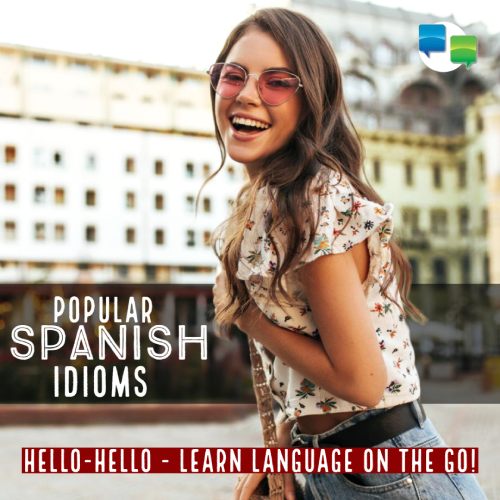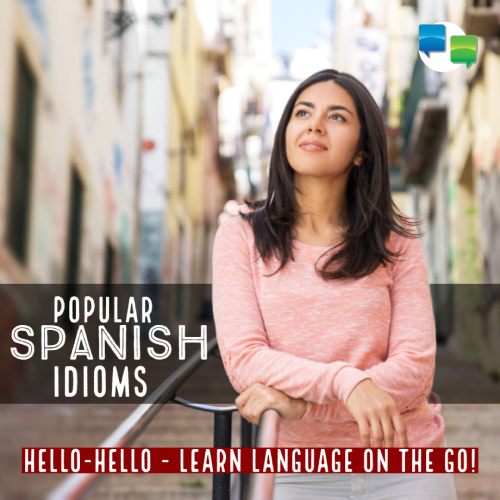Learning a new language involves more than merely memorizing vocabulary and mastering grammar rules. It also needs to understand the cultural nuances and expressions that make native speakers sound natural and fluent. Idioms are an integral part of any language, lending color and depth to everyday conversations.
This article, from Hello-Hello the leading language learning app developer and creator of the famous iOS app, “Learn Spanish with Hello-Hello“, explores some of the popular Spanish idioms that will help you sound like a native speaker.
“Estar en las nubes” (To be in the clouds)
This idiom is used when someone is daydreaming or not paying attention to their surroundings. It describes a person who is mentally absent or lost in their thoughts.
Example: “No le hagas caso, está en las nubes” (Don’t mind him, he’s in the clouds).
“Meter la pata” (To put one’s foot in it)
This idiom means to make a mistake or say something inappropriate or embarrassing. It refers to figuratively putting your foot in your mouth. Example: “Juan metió la pata al preguntarle a María si estaba embarazada” (Juan put his foot in it by asking María if she was pregnant).
“Estar en las manos de alguien” (To be in someone’s hands)
This idiom means to be under someone’s control or at someone’s mercy.
Example: “El futuro del proyecto está en las manos del jefe” (The future of the project is in the hands of the boss).
“Dar en el clavo” (To hit the nail on the head)
This idiom is used when someone makes an accurate or precise statement or guess.
Example: “Creo que sé quién ganará el concurso, pero quiero asegurarme. ¡Diste en el clavo!” (I think I know who will win the contest, but I want to make sure. You hit the nail on the head!).
“Echar leña al fuego” (To add fuel to the fire)
This idiom means to worsen a situation or make it more contentious by saying or doing something that aggravates it.
Example: “No le digas eso a Juan, solo estarás echando leña al fuego” (Don’t say that to Juan, you’ll just be adding fuel to the fire).
“Costar un ojo de la cara” (To cost an eye from the face)
This idiom is used to describe something that is very expensive or costs a fortune.
Example: “El nuevo iPhone cuesta un ojo de la cara” (The new iPhone costs an eye from the face).
“No tener pelos en la lengua” (To not have hairs on one’s tongue)
This idiom describes someone who speaks their mind freely and without hesitation, often being blunt or straightforward.
Example: “María siempre dice lo que piensa, no tiene pelos en la lengua” (María always speaks her mind, she doesn’t have hairs on her tongue).
“Salir el tiro por la culata” (For the shot to come out through the breech)
This idiom is used when things don’t go as planned or when an action has unintended consequences.
Example: “Juan intentó hacerle una sorpresa a María, pero salió el tiro por la culata” (Juan tried to surprise María, but it backfired).
“Tener la mosca detrás de la oreja” (To have the fly behind the ear)
This idiom means to be suspicious or have a feeling that something is not right.
Example: “No sé por qué, pero tengo la mosca detrás de la oreja con ese nuevo vecino” (I don’t know why, but I have a feeling that something is off with that new neighbor).
“Ser pan comido” (To be eaten bread)
This idiom is used to describe something that is easy or a piece of cake.
Example: “No te preocupes por ese examen, será pan comido para ti” (Don’t worry about that exam, it will be a piece of cake for you).
Mastering idioms is an essential part of becoming fluent in a language. These ten popular Spanish idioms will not only enhance your conversational skills but also help you better understand Spanish culture and express yourself more authentically. So go ahead, incorporate these idioms into your language learning journey, and soon you’ll be sounding like a native Spanish speaker!
Note: If you are unsure about which app to opt for your language learning. Then you may start with Hello-Hello Complete to learn 13 leading foreign languages or may try Hello-Hello’s Spanish language learning app Learn Spanish (Hello-Hello).
Check out the new version of our Spanish language learning app for iPhone and iPad. Learn Spanish with Hello-Hello offers a completely new and improved version of our app with animated videos, redesigned interface and additional features! Follow our adorable characters on a fun journey to learn Spanish!
Seriously, this is now, by far, THE BEST language learning app available on iTunes 🙂
- Animated videos and comic strips.
- New games to practice reading and listening skills
- Cleaner and more friendly user interface
- Follow your course progress
- Take notes
- Receive notifications with lesson reminders. The more you practice, the more you learn!
- Receive notifications with new words to build your vocabulary
Check out the iTunes store Hello-Hello Spanish app here




